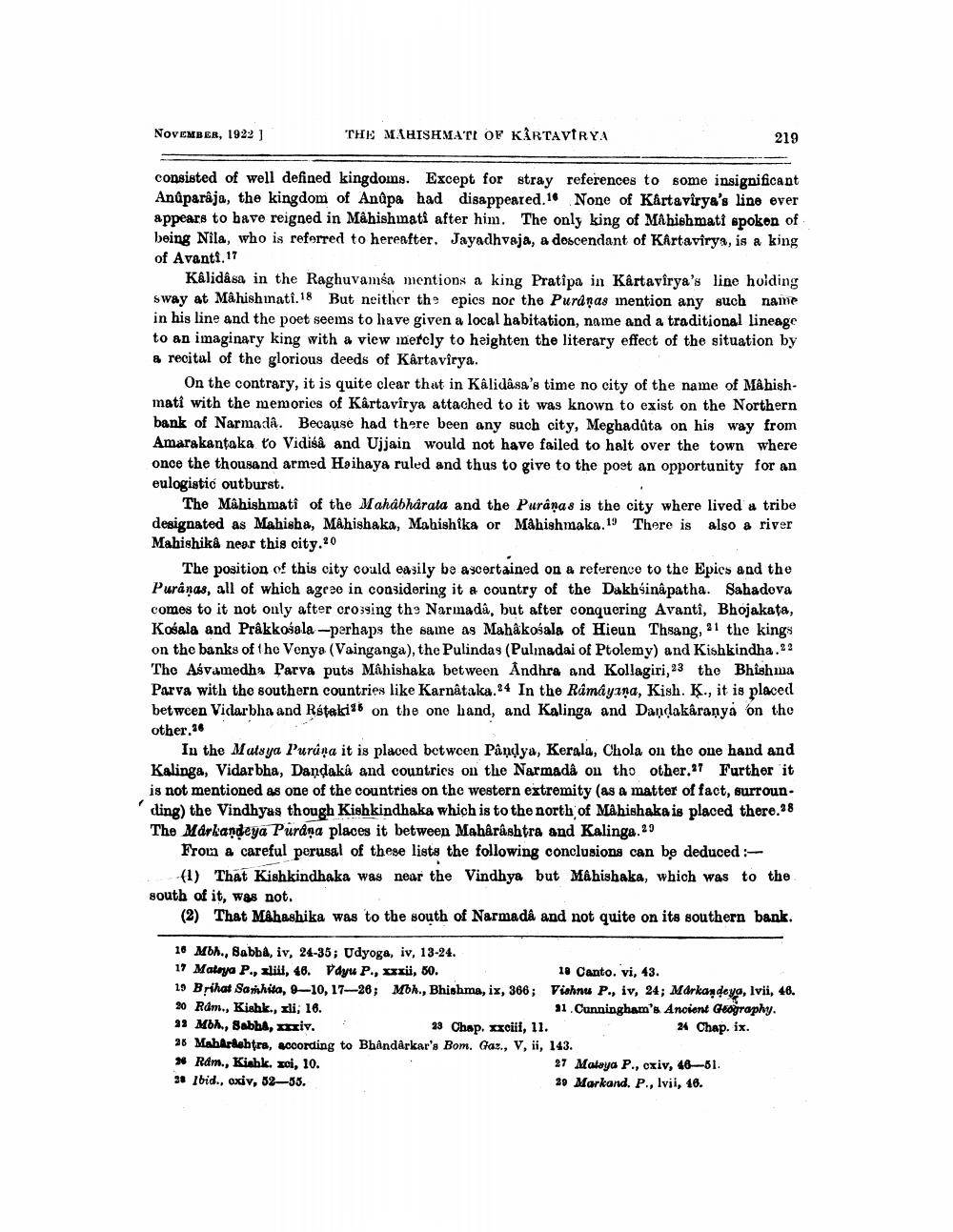________________
NOVICMBER, 1922)
THE MAHISHMATI OF KĀRTAVERYA
219
consisted of well defined kingdoms. Except for stray references to some insignificant Anûparaja, the kingdom of Anûpa had disappeared.16 None of Kärta virya's line over appears to bave reigned in Mahishinati after him. The only king of MAhishmati spokon of being Nila, who is referred to hereafter. Jayadhvaja, a doscendant of Kartavirys, is a king of Avanti.17
Kalidasa in the Raghuvamsa mentions a king Pratîpa in Kårtavirya's line holding sway at Mahishmati.18 But neither the epics nor the Puraņas inention any such name in his line and the poet seems to have given a local habitation, name and a traditional lineage to an imaginary king with a view merely to heighten the literary effect of the situation by & recital of the glorious deeds of Kärtavîrya.
On the contrary, it is quite clear that in Kalidasa's time no city of the name of Mâhishmatî with the memories of Kârtavîrya attached to it was known to exist on the Northern bank of Narmada. Because had there been any such city, Meghadůta on his way from Amarakantaka to Vidisâ and Ujjain would not have failed to halt over the town where once the thousand armed Haihaya ruled and thus to give to the poet an opportunity for an eulogistic outburst.
The Mâhishmati of the Mahabharata and the Puranas is the city where lived a tribe designated as Mahisha, Mahishaka, Mahishika or Mahishmaka.19 There is also a river Mahishika neor this city.20
The position of this city could easily be ascertained on a reference to the Epics and the Puranas, all of which ageso in considering it a country of the Dakhsinapatha. Sahadova comes to it not only after crossing the Narmada, but after conquering Avanti, Bhojakata, Kosala and Prakkosala -perhaps the same as Mahakosala of Hieun Thsang, ai the kings on the banks of tho Vonyo (Vainganga), the Pulindas (Pulmadai of Ptolemy) and Kishkindha.? The Asvumedha Parva puts Mâhishaka between Andhra and Kollagiri, 23 the Bhishma Parva with the southern countries like Karnataka.24 In the Ramayana, Kish. ķ., it is placed between Vidarbha and Rstakia on the one hand, and Kalinga and Dandakâranya on the other.36
In the Mutsya Puruņa it is placed between Pandya, Kerala, Chola on the one hand and Kalinga, Vidarbha, Dandaka and countries on the Narmada on tho other.97 Further it is not mentioned as one of the countries on the western extremity (as a matter of fact, surroun. ding) the Vindhyas though Kishkindhaka which is to the north of Mahishaka is placed there.38 The Märkandeya Purana places it between Mahârâshtra and Kalinga 29
From a careful perusal of these lists the following conclusions can be deduced :
(1) That Kishkindhaka was near the Vindhya but Mâhishaka, which was to the south of it, was not.
(2) That Mahashika was to the south of Narmada and not quite on its southern bank.
10 Mbh., SabbA, iv, 24-35; Udyoga, iv, 13-24. 17 Maloya P., xliil, 46. Vayu P., xxxü, 50.
18 Canto. vi, 43. 19 Brihat Samhita, 9-10, 17-20; Mon., Bhishma, ix, 366; Vishnu P., iv, 24; Markandeya, Ivii, 46. 20 Rdm., Kishk., xli, 16.
31. Cunningham's Ancient Geography, 33 Moh., Sabba, xxiv.
33 Chap. xxciii, 11.
24 Chap. ix. 26 MahArtehtra, according to Bhandarkar's Bom. Gaz., V, ii, 143. * Ram., Kishk. xoi, 10.
27 Matsya P., oxiv, 46-51. 21 Ibid., oxiv, 62—35.
29 Markand. P., Ivii, 16.




